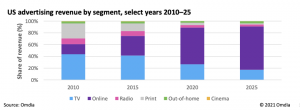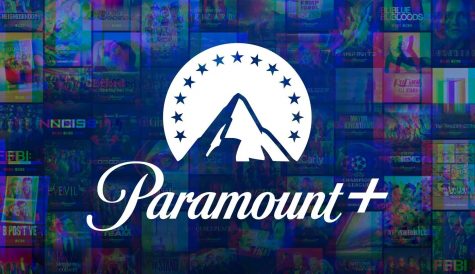
After more than 40 years of operation, DTVE is closing its doors and our website will no longer be updated daily. Thank you for all of your support.
Omdia: shift of ads to online will force traditional media to collaborate
Traditional media players are coming under increasing pressure from the shift of advertising to online and will need to collaborate to develop the scale required for advanced TV advertising to compete with the data-driven walled gardens of YouTube and Facebook, according to a new report from Omdia.
 Omdia says that online advertising accounted for 58% of all media advertising last year and will account for over 70% of worldwide ad revenue by 2025.
Omdia says that online advertising accounted for 58% of all media advertising last year and will account for over 70% of worldwide ad revenue by 2025.
With digital and traditional media buying currently operating in separate silos in data, measurement, sales processes and distribution advertisers are finding it difficult to develop cross-platform campaigns. Addressable advertising in the TV segment, which is being driven primarily by pay TV operators in the US, will require much greater industry collaboration to build scale to compete with tech giants, according to senior principal analyst Marija Masalskis.
According to the report, Advanced TV Advertising, traditional TV’s share of overall video revenue in the US will fall below 50% in the US in the net two years, but traditional and connected TV advertising combined will remain the dominant audiovisual advertising segment.
According to Omdia, there are currently around 436 million connected TV devices and 85 million addressable pay TV set-top boxes in the US market, giving advertisers an opportunity to launch targeted campaigns. Masalskis says that the decline of pay TV is acting as a spur to collaboration and innovation, with broadcasters and channel providers seeking to compensate lost carriage fee revenues and offset the decline in linear viewing while pay TV operators invest in addressable technology to prop up their legacy advertising revenues.
This has led US pay TV operators Comcast, Cox and Charter to combine efforts under the Ampersand JV while Comcast, Charter and Cox launched their On Addressability initiative in 2019.
While pay TV advertising will continue to grow despite cord cutting, broadcaster-owned services will dominate the US connected TV advertising segment, according to Omdia, which expects the connected TV market in the US to be worth US$20 billion by 2025.
Omdia expects a shift towards ‘audience-based buying’ in the US, meaning that inventory will be split among different buyers targeting different audience segments, rather than a single advertiser sending different ads to different audience segments within the same slot. This will be accompanied by a move towards an ‘omnichannel’ approach to buying, with campaigns across TV and digital, including the walled gardens of major tech giants.
At the same time, says Masalskis, pay TV operators and connected TV device manufacturers will increasingly compete to be the go-to intermediary enabler of addressable advertising.
By contrast with the US, addressable advertising in Europe is still relatively in its infancy. Both pay TV addressable advertising and connected TV advertising are expected to grow more slowly, with broadcasters under less pressure from the switch of advertiser spending to digital.
Moves by pay TV operators towards super-aggregation and the already vibrant broadcaster VOD market in Europe may encourage the development of advanced advertising. Masalskis also points out that ‘audience-based currencies’ are already widely used in Europe, and a switch to audience-based buying would not be difficult to manage.
However, pay TV operators are mostly relatively new to the advertising market unless they have sold ads against their own linear channels on the model of Sky, while on the free-to-air broadcaster side, there is also no commercial entity behind the HbbTV hybrid TV standard, even though addressable advertising is part of the spec, and privacy regimes are stricter.


